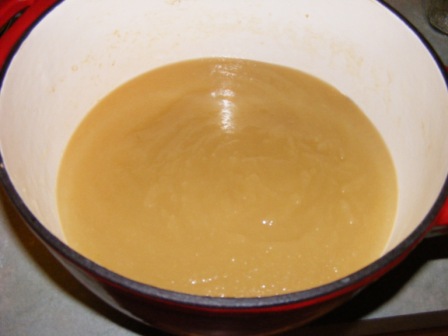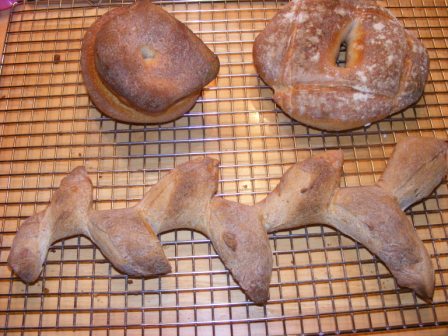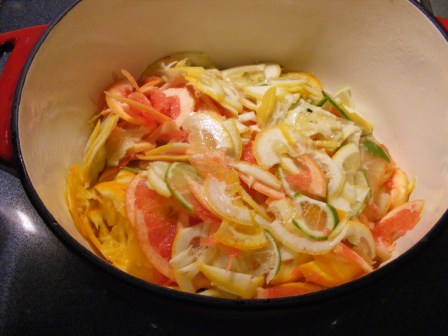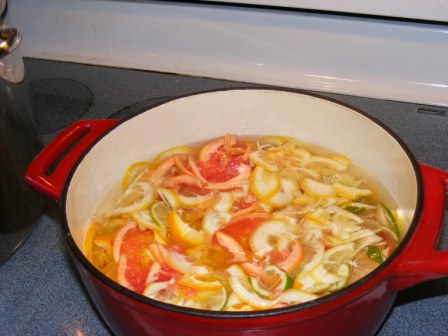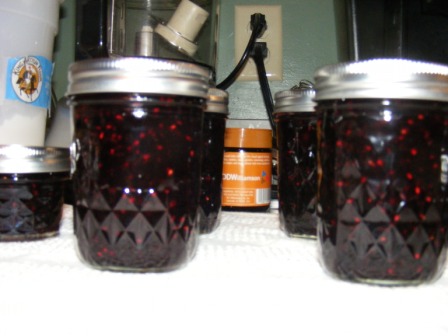Last weekend, my friend Kevin and I went to a mutual friend’s house to pick grapes. She is out of town and said we could come harvest the grapes when they were ripe. We were planning to bring the grapes back to my house to make and can jelly. Although I have made freezer jelly, this was to be my first time canning. I went to the store the day before we were going to pick the grapes and bought canning jars, lids and pectin.
It may surprise you that someone who cooks as much as I do has never canned before. It surprises me, too. I’ll have to talk to my mom about that the next time I see her. Yet another deficieny in my culinary education (I had to teach myself to make injera bread, too, if you can believe it).
After buying the supplies, I went home and read the inserts in the pectin containers, the Better Homes and Gardens Cookbook section on canning, and of course a bunch of (often conflicting) information about canning online. Armed with that knowledge (and the knowledge that Kevin would be here and had experience in these matters), I was ready to make grape jelly.
Or so I thought. We got to our friend’s house only to discover that, while we were ready for the grapes, they weren’t ready for us.
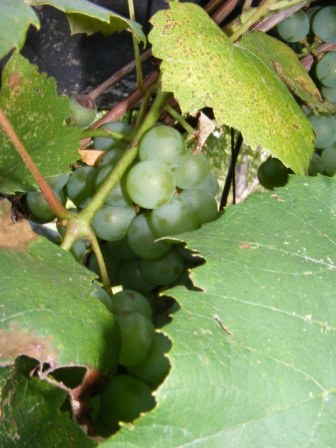
They were close to being ripe, but not quite there yet. Maybe in a week or so. Our friend is out of town for a few months, so we decided to see what else she had growing in her garden. We picked a bunch of jalapeno and Anaheim peppers and decided to make hot pepper jelly that afternoon. One thing led to another, including lunch with Kevin, my wife and daughters at Outback Steakhouse, and we never got as far as making the jelly before Kevin had to leave.
Undaunted, but with more than a little trepidation, I decided to make and can the jelly myself. I knew that the jelly would be fairly easy; it was the canning that had me worried. But armed with my recently-acquired knowledge, I decided to have a go at it anyway.
In addition to the peppers we had harvested that day, I had a number of peppers that I had received in my CSA boxes the past few weeks. So I decided to make one batch of jalapeno jelly and, if it wasn’t a total disaster, a batch of mixed pepper jelly.
My canning jars and lids had already been washed in the dishwasher. I put the jars on their sides in my makeshift canner (a large stockpot with a round rack set in the bottom), added enough hot water to cover the jars, then covered the pot and put it on the stove over medium-high heat. I put the lids in a small saucepan of water and brought it to a simmer. I let both of these continue to simmer while I made the jelly.
I stemmed and seeded about 12 jalapenos, then whirred them in the food processor with a cup of cider vinegar to a nice mush, which I put into a saucepan with another cup of vinegar and 6 cups of sugar. I boiled the mixture for 10 minutes (note for future reference: don’t inhale the steam from 12 jalapenos), then added liquid pectin and boiled another minute.
Showtime. Time to fill the jars and process them in the hot water bath. Once I worked out a system of where to put the jars, how to fill them, etc., it really was a rather simple process. I ended up with 5 pints of jelly, which I processed in the hot water bath for 10 minutes. Then I turned off the heat, removed the lid, and let them rest in the water an additional 5 minutes.

Within a minute or so of taking the jars out of the water, I started to hear these popping, plonking noises, which I was sure meant I had done something terribly wrong and ruined the whole thing. As it turns out, it was just the lids sealing themselves. The jelly was thick, but still a bit goopy-looking, but I figured (hoped) it would firm up as it cooled.
Interstingly, making the jelly was by far the hardest part of the whole operation. Flush with that success, how could I but try again? For my next trick, I would make 6-pepper jelly, featuring about 1/4 jalepenos and the rest a mix of green and yellow bell peppers, Anaheims, poblanos, and another pepper I got in my CSA but wasn’t sure what it was.
This time, I decided to chop the peppers up in the food pro but stop short of pureeing them, as I wanted chunks of peppers visible in the jam.


I put the not-quite-puree into the pot, added a cup of cider vinegar, and an envelope of powdered pectin. Then I went to measure out the sugar, and found out I had a problem. The recipe I was sort of following called for 5 cups of sugar, but I only had 3 1/2 cups. Ah, no matter. I remembered Kevin saying that he automatically cut the sugar in most jam and jelly recipes by half, so I didn’t worry. Turns out maybe I should have.
I cooked the jelly, then filled and processed the jars. The jelly was beautiful.


The jalapeno jelly had already started to set up. And I was so pleased with the look of the second batch, I didn’t notice that the pepper pieces were floating to the top of the jar. As the 6-pepper jelly cooled, I kept checking it, but it never set. It was about the consistency of runny syrup.
Back to the ‘net to try to diagnose my problem. It didn’t take long to figure out that cutting back on the sugar was the most likely culprit. It seems that sugar has almost as much to do with making the jam set as the pectin. As I was out of sugar (hence the problem in the first place), and it was too late to go out and get more, I let the jam sit for the night. There was always the hope that it might have set by morning.
Morning came, like it does, but the jam was as soupy as it had been the night before. So, off to the store for sugar and home to attempt a rescue. I made a pectin syrup by boiling a packet of gelatin in 3/4 cup of water. I added 1 tablespoon of this syrup for each pint of jam, along with the remaining sugar, then boiled this mixture for a minute or so. I put the jam into clean jars and reprocessed it in the hot water bath.
It still took a while for the jam to set up, but it did, as you can see by the fact that the peppers are evenly spread throughout the jam in this picture.

The jars all sealed, and both batches look and taste wonderful. With 2 successes, and 1 small setback, I feel ready to tackle more canning.
Come on grapes!!























